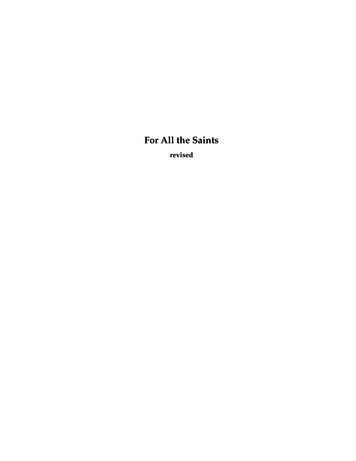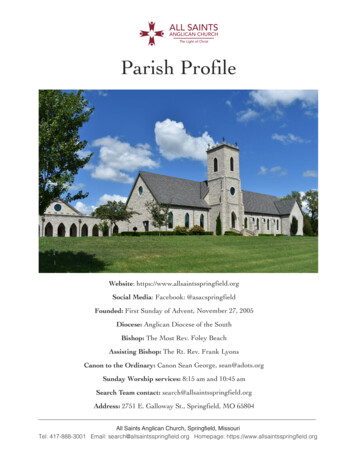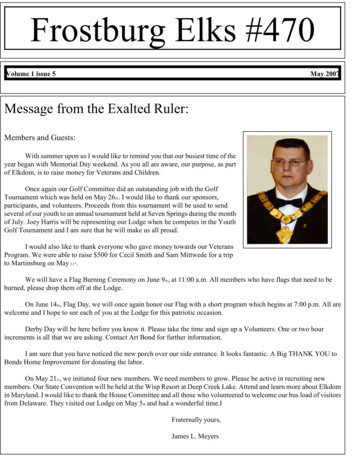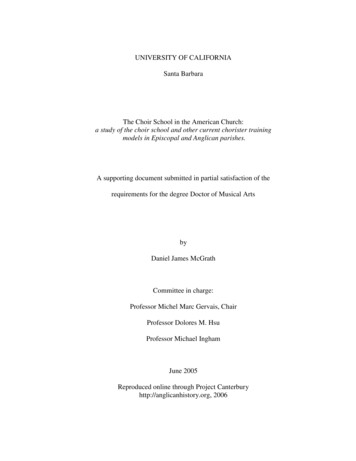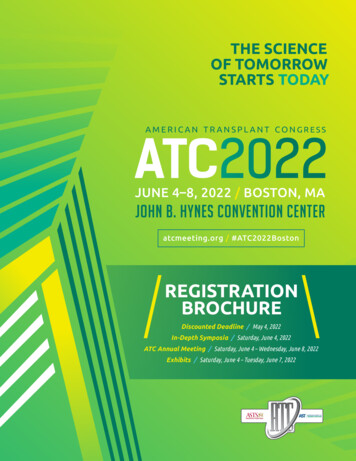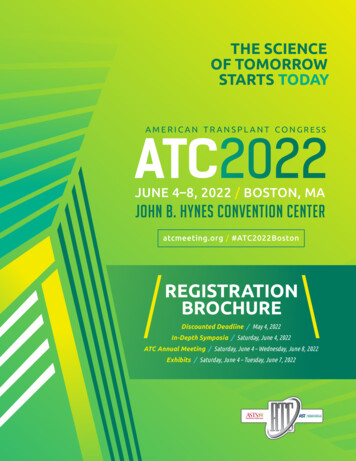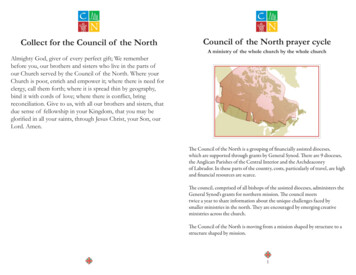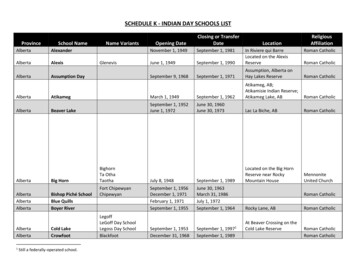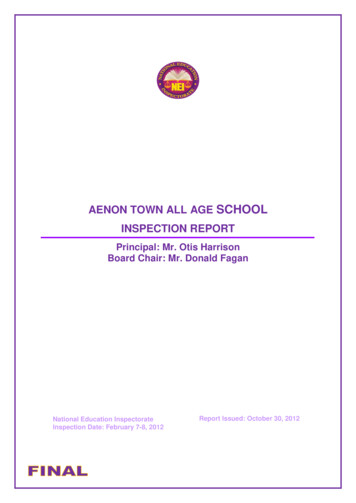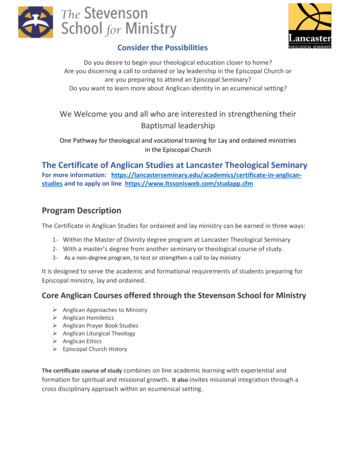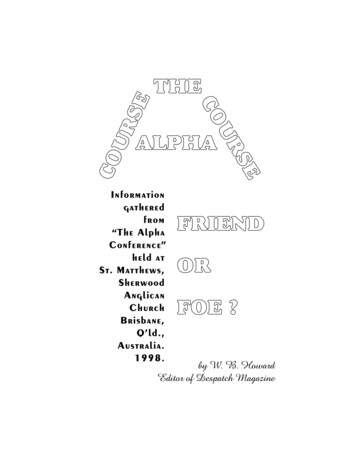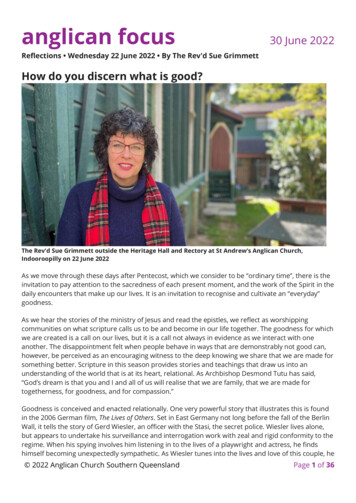
Transcription
anglican focus30 June 2022Reflections Wednesday 22 June 2022 By The Rev'd Sue GrimmettHow do you discern what is good?The Rev'd Sue Grimmett outside the Heritage Hall and Rectory at St Andrew’s Anglican Church,Indooroopilly on 22 June 2022As we move through these days after Pentecost, which we consider to be “ordinary time”, there is theinvitation to pay attention to the sacredness of each present moment, and the work of the Spirit in thedaily encounters that make up our lives. It is an invitation to recognise and cultivate an “everyday”goodness.As we hear the stories of the ministry of Jesus and read the epistles, we reflect as worshippingcommunities on what scripture calls us to be and become in our life together. The goodness for whichwe are created is a call on our lives, but it is a call not always in evidence as we interact with oneanother. The disappointment felt when people behave in ways that are demonstrably not good can,however, be perceived as an encouraging witness to the deep knowing we share that we are made forsomething better. Scripture in this season provides stories and teachings that draw us into anunderstanding of the world that is at its heart, relational. As Archbishop Desmond Tutu has said,“God’s dream is that you and I and all of us will realise that we are family, that we are made fortogetherness, for goodness, and for compassion.”Goodness is conceived and enacted relationally. One very powerful story that illustrates this is foundin the 2006 German film, The Lives of Others. Set in East Germany not long before the fall of the BerlinWall, it tells the story of Gerd Wiesler, an officer with the Stasi, the secret police. Wiesler lives alone,but appears to undertake his surveillance and interrogation work with zeal and rigid conformity to theregime. When his spying involves him listening in to the lives of a playwright and actress, he findshimself becoming unexpectedly sympathetic. As Wiesler tunes into the lives and love of this couple, he 2022 Anglican Church Southern QueenslandPage 1 of 36
begins taking risks to protect them from his own officers, thereby putting himself in danger. Courageand empathy grow in him as he appreciates beauty and nobility in what he witnesses, while growingin understanding of those he previously persecuted.Our humanity is only revealed as we draw nearer in relation to one another. The story of the Stasiofficer in the film relates how one man reclaims his humanity when he allows the truth of two peopleto touch his heart. The juxtaposition of coercive and invasive political power being unravelled byindividual compassion is compelling.Goodness is astonishingly particular, appearing in particular ways in the context of all our interactionsand in the way we tend to our relationships. It takes the presence of another to break open our heartto see and feel something in a new way. We are transformed by our empathetic engagement withperspectives that are different to our own. And, we find our goodness in every moment ofcompassion and loving kindness that emerges in the space between us as we share our lives together.As we read through the stories of Jesus’ ministry in this “Ordinary Time” of the Church, we may bereminded to attend closely to the goodness we are called to in each and every relationship, each andevery day. It is a time to hear afresh the invitation to join the Spirit as co-creators of the kingdom onearth, recognising what is sacred and beautiful in the lives of others whom we are privileged toencounter.Features Wednesday 22 June 2022 By Aaron VidyasagerWhen Aaron met the AuntiesACSQ RAP Coordinator Aunty Sandra King and Community of The Way member Aaron Vidyasager lovecatching up, as they did on 22 June 2022 at St Francis CollegeWhen I interact with First Nations peoples, the main way I connect with them is as a Tamil man. Tamilsare an ethnic and language group originating from the south of the Indian subcontinent. Tamil is anPage 2 of 36
ancient language that has been spoken for 5,000 years. My family is from Chennai, the capital city ofthe Indian state of Tamil Nadu, and Madurai, which is also in Tamil Nadu.I’ve noticed that Tamil and First Nations peoples share similar cultural aspects. For example, recentlyat a Mabo Day event at Holy Trinity Anglican Church, Fortitude Valley, Aunty Sandra King, the DiocesanReconciliation Action Plan Coordinator, was relating to me just like one of my aunties would. Sheasked me about my family, how I am going with my life and why I was wearing a particular hoodie.At the same event, a Torres Strait Islander Aunty who looked just like my acchi (grandma), whorecently passed away, seemed very concerned that I wasn’t eating enough at the event. She alsoenquired to make sure that I was going to church every Sunday. During the fellowship time, she evengestured to me from the other side of the church hall to make sure that I was eating enough. We hadjust met that night.This Elder and Aunty Dr Rose Elu, whom I also met at the event, asked me what island I am from andwhat my surname is. They were surprised to discover I wasn’t a Pacific Islander and that my surnameis Vidyasager.The ‘aunty’ love that all these Elders, and other First Nations Aunties, show me is the same kind of lovethat my flesh and blood aunties show me. The way these First Nations Aunties ask about my familyand whom I am connected to is shared between my culture and theirs.So culture for me is more than about how people look, the dances we dance, the music we listen orthe art we create – it’s about how we show love, how we relate to one another.NAIDOC Week celebrates Aboriginal and Torres Strait Islander cultures and traditions. It alsocelebrates Aboriginal and Torres Strait Islander histories.I come from a country that was also colonised by the British – we struggled as well. It’s great to seebrown people who look like me celebrating their resilience – their cultures, traditions and spiritualitiesthat have endured such hardship historically.I think it’s really important for kids and adults alike to be proud of their cultures and traditions and theskin they are born in – these make us special and strong. I was speaking to Aunty Sandra about this atthe Mabo Day event, and like any loving aunty would, she encouraged me to be proud of being Tamil– to stand up and be proud of who I am, my culture and being a brown man.Page 3 of 36
“One of the ways we can create systemic change is by learning about and supporting the UluruStatement From The Heart” (Aaron Vidyasager, Community of The Way member, June 2022)This year’s NAIDOC Week theme is “Get Up! Stand Up! Show Up!” I think for Anglicans, this year’stheme is a real wake-up call – I think we need to get up and attend events being held during NAIDOCWeek. I think we need to stand up against injustices that we see. And, we need to show up when itcomes to creating systemic change.One of the ways we can create systemic change is by learning about and supporting the UluruStatement From the Heart. In her recent Mabo Day service address, Aunty Rose spoke about how theStatement “is a gift to all Australians – a roadmap to fairness and meaningful change.”The Statement calls for an Indigenous Voice to Parliament enshrined in the Constitution. As AuntyRose says, “By supporting the Voice, we are taking another meaningful step forward towardsReconciliation. A Voice to Parliament that is included in the Constitution will give us all the best chanceof finally closing the health and life expectancy gap between Indigenous and non-IndigenousAustralians.”I plan to get involved in NAIDOC Week events – I hope to see you there, whether online or in person.Editor’s note: NAIDOC Week will be held between Sunday 3 July and Sunday 10 July 2022. Findout more about this year’s NAIDOC Week events by visiting the anglican focus Events page. Formore information and resources for this year’s NAIDOC Week, please visit the NAIDOC Weekwebsite and the faithful effective website. For more information about the Voice toParliament, please visit the From The Heart website.Page 4 of 36
Reflections Thursday 23 June 2022 By The Rev’d Dr Carol HebronFinding the fountain of youth in retirement"We have an activity centre that enables us to have Anzac Day, Remembrance Day and Christmasservices. In my unit we have Lenten and Bible Studies and a monthly Eucharist" (The Rev'd Dr CarolHebron)There was no set date for my retirement. No celebration. No intentional, “Now I begin a new stage ofmy life!” Perhaps it was my decision not to continue lecturing at St Francis College that led to myretirement. I think receiving my Pensioner Concession Card was the clincher. Nevertheless, I simplymorphed into retirement and I’m loving it.The last five years for me can be variously described as extraordinary, never dull, sometimeschallenging, anxious, deeply sad and deliriously happy. What still amazes me is that when I firstpresented for ordained ministry, I felt called to serve elderly people. So I used to make weekly visits toSinnamon Village Aged Care in Sinnamon Park. Now, some four decades later, I am ministering toresidents of Springwood Yurana Aged Care Facility and my neighbours and friends of YuranaIndependent Living. How blessed I am!The great Italian actress Sophia Loren once said, “There is a fountain of youth: it is your mind, yourtalents, the creativity you bring to your life and the lives of people you love. When you learn to tap thissource, you will truly have defeated age.” Retirement makes it possible for me to drink from thisfountain. My idyllic life here at Yurana has enabled me to do what I believe I am called to do.What have I been doing since “retirement”? Lots! My Permission to Officiate (PTO) licence within TheParish of Logan has enabled me to continue my priestly vocation.I have mastered the use of PowerPoint presentations, which makes it easier for elderly people to singhymns – ‘Shine Jesus Shine’ is a favourite – and to join in the responses and prayers. The sermons arePage 5 of 36
interactive with residents sharing their pearls of wisdom. I am blessed to lead Anzac Day,Remembrance Day and Christmas services.The liturgical Triduum services of Maundy Thursday, Good Friday and Easter Sunday are “done” in onesitting. It is such a privilege to share this journey with the residents, and to witness their emotionalresponses to the liturgy. Hearing their joyous and spontaneous “Alleluia” outbursts is quite humbling.On a more one-to-one level, I take communion to some of the aged care residents. At the request of afamily member, I visit their loved one and listen to and pray with them. I recall having to make onesuch visit during a “lockdown”. I had to wear full personal protective equipment. I can’t fully describehow restrictive and uncomfortable that was. Nor can I describe how truly blessed I felt to tend tosomeone in this uniquely personal way during this once-in-century event.I also minister to residents of Independent Living. It’s important to note that the residents of Yuranaand Independent Living also minister to me. For example, when I was unwell dealing with a cancerdiagnosis, the residents visited me, prayed for me and gave me enormous strength.We have an activity centre that enables us to have Anzac Day, Remembrance Day and Christmasservices. In my unit we have Lenten and Bible Studies and a monthly Eucharist.COVID-19 impacted how we all “do” Church, and so I also had to adapt. Because I live in a villagewhere there are very elderly people onsite, during the thick of COVID-19 I needed to be really careful,so Church for me was about more personal prayer.COVID-19 continues to impact us here at Yurana, so we’ve been limited in our group gatherings. Theone positive thing about COVID-19, especially throughout the lockdowns, is that I didn’t have to referto my calendar diary. It’s also one of the bonuses of being retired. It is quite liberating living a life thatisn’t dictated by a diary entry. I can choose and decide what I add to my diary. Mind you, this meansthat I’ve missed remembering a couple of birthdays and anniversaries along the way.So what do I do with all this free time that retirement offers? Lots! The most time-consuming, themost demanding, the most stressful, and yet the most fulfilling activity was co-authoring with mysister, Lynette, a 165,000-word book. The title is Holocaust In World Cinema: Jews Judaism God. Thewriting journey took seven years. It involved researching, learning about Judaism in books, and theviewing of around 350 Holocaust themed films. Our focus was on how Jews, Judaism and God areportrayed in the films. The book is completed and is awaiting appraisal from a publisher.Motivational speaker and writer Lee M. Brower says that, “A thriving new beginning can be and shouldbe a time for amazing engagement, growth, connections, contributions, and amazing possibilities.” Ihave certainly found this to be true of my retirement.For clergy who may be apprehensive about retiring, let me say this. Remember: priesthood isn’t a job.It’s a vocation – a way of living and being there for others. Retirement offers freedom from “busy”diaries and many mandated obligations. Retirement also offers choices, decisions, and in discerningthe degree in which we can and want to participate in our community.Although, there does need to be some structure. For me this is beginning and ending each day“sitting” quietly with God. So far this has worked for me. I am where I am meant to be. My lifecontinues to blossom. Thanks be to God!Page 6 of 36
Editor’s note: The Parishes and other Mission Agencies Commission is continuing to host eventsfor clergy related to retirement, finances and superannuation. The following events are comingup in 2022:Thursday 25 August 1-2.30 pm via Zoom: Exploring Clergy Retirement (Register online)Wednesday 7 September 2-3.30 pm via Zoom: Superannuation (Register online)Features Tuesday 28 June 2022 By Angie MooneyPilgrimage to the Waddananggu communityIn May 2022, Wangan and Jagalingou Traditional Owners Meisha, Coedie and Nathan welcomedCathedral parishioner Angie Mooney to Country, where they are keeping vigil near the Adani CarmichaelmineI grew up in rural News South Wales near Goulburn in the late 1970s to 1990s. My family taught me tobe proud of my First Fleet and “pioneer” backgrounds. My ancestors were the first non-Indigenousfamily to own land in the area. My father saw himself as a steward rather than a landowner – but asteward for future generations, not for Gundungurra people’s Country. He was a man of his time.However as a child I always felt a longing to know more about First Nations peoples and wished I hada connection with them.My father shared with me a lot of oral history about the Gundungurra people on the property. Forexample, he told me where a bora ring used to be located in the paddock behind our house – it was aceremonial meeting place. The creek running beside it was significant, also. He told me the name ofthe last Aboriginal man on the property that my ancestors used to give food to.My father’s cousin, Sr Camille Poidevin, was a Catholic nursing nun. For many decades she cared forAboriginal people in the Derby Leprosarium, also known as Bungarun in the Kimberley region ofWestern Australia. The leprosarium opened in 1936 and cared for Aboriginal people suffering fromleprosy across Western Australia and the Northern Territory until it was closed in 1986. Camille had aPage 7 of 36
profound impact on my faith formation – not in the sense of an instutionalised faith. Rather herexample caring for First Nations peoples who had leprosy showed me what faith in action looks like.I visited her and the other nuns in Derby in 1996. She told me about the lack of understanding thatmany non-Indigenous people have for the First Nations way of life and why certain measuresimplemented to assist these communities would fail. She was never pushy with anything – she justshowed me things. She took me to the grave sites of people who had died of leprosy and to culturalsites in the Kimberley. I yarned with Traditional Owners. And, we visited those in prison.Camille believed that First Nations peoples should be encouraged in their traditional spirituality – intheir connection to Country. She wasn’t interested in imposing her religion onto anyone – yet throughher actions and attitudes towards all people I saw what living the Gospel looked like. She was highlyrespected in her community by the Traditional Owners and was awarded an Order of Australia Medal,which she only accepted on behalf of the community of Sisters.Fast forward to now, and I am worshipping in our Diocese after being received in the Anglican Churchfour years ago. Because I am a member of the Cathedral community, which is known for itscommitment to advocacy and justice, I became aware that my inaction in the environmental and FirstNations justice spaces went against my faith. I realised that as a Christian I have a responsibility to dosomething and that pushing against oppressive systems that marginalised people is what Jesus did.At the same time, I have met and connected with people who do not ascribe to any religion and arevery committed to environmental and First Nations justice. I saw these people demonstrating theGospel message better than myself. They have showed me what it means to follow Jesus.As part of this awakening, I recently travelled to the North Galilee Basin where I was ceremoniallywelcomed by the Waddananggu community. Waddananggu means “the talking” in Wirdi language. Istayed with the community for a week along with 30 other supporters. During this time, we wereshown spiritually significant sites, including Doongmabulla Springs, a one-of-a-kind ecosystem – adesert Country oasis. It is the resting place of their creator spirit, the Rainbow Serpent known asMundunjudra. We were taught language and respectful interactions with the land and each other. Wecollected dead branches of gidgee wood to make clap sticks for ceremony. I learnt that gidgee isculturally significant and that gidgee trees grow so slowly that what looked like a large hardy bush wasa 400-year-old tree. We were also shown scar trees, which marked burial grounds.The Waddananggu community is located on the Adani Carmichael mining site. The Wangan peopleand the Jagalingou people have been keeping vigil there since August last year. They maintain aconstant presence on Country to care for and protect their land. They are concerned about the impactof the mine on Country, including on their cultural practices, gidgee trees and ground water (andassociated impacts on the Doongmabulla Springs).I feel compelled after returning from my trip to engage more in justice and to educate myself further.For example, at the Cathedral’s recent open space visioning day, I put forward the need for thecommunity to intentionally improve our cultural competency and address First Nations injusticemore. I have also met up with a Yuggera Traditional Owner at Deebing Creek near Ipswich, and I amplanning on visiting again soon to join them in a healing and talking circle.I am very grateful to the Waddananggu community for welcoming me. It was such a privilege to be sowelcomed to their Country and to learn about their culture and history. I felt empowered andPage 8 of 36
humbled by their welcome. The Wangan and Jagalingou Traditional Owners make everyone an “us” –they are inclusive of all even though they have been “othered” since colonisation. I encourageeveryone to support them.Editor’s note: Find out more about this year’s NAIDOC Week events by visiting the anglicanfocus Events page. For more information and resources for this year’s NAIDOC Week, pleasevisit the NAIDOC Week website.Features Wednesday 22 June 2022 By Allana WalesA reckoning that becomes a channelAllana Wales with the Thread Together van at St Andrew’s Anglican Church, Indooroopilly on 19 June2022Upon reflecting on the phrase “Better Together”, the 2022 theme for National Volunteer Week inAustralia, I am reminded that this is one translation of the Zulu philosophy of ubuntu – the wellbeingof ourselves being intrinsically caught up in the wellbeing of others, often translated as “I am becausewe are”. As such, I believe we are each custodians of each other’s care, and that the meaningfulpurpose inherent in volunteering is just one way of encountering the diversity of humanness thatexpands and shapes us for the better.I have been involved in the Thread Together project since its inception as part of the ministry of StAndrew’s Anglican Church, Indooroopilly and Thread Together’s partnership with Anglicare SouthernQueensland. It is a joy and a deep privilege when I am able to drive the van from our parish to sites, tosort and move boxes of clothing, to help guests choose their new clothing and to be part of a widermovement for merciful action.I often come away from this volunteering with a sense that all involved have been custodians of eachother’s care, choices and dignity. I come away aware that I have undertaken something that has beena gift to me. I believe there is an intangible empowerment for good on both sides of a perceived dividePage 9 of 36
– made manifest in the tangible purposing of new clothing for those in need – that means thewellbeing of both is enriched.The Church’s gift of diversity within its own community is exhibited in the life of volunteers. It may bethat one volunteer has particular strengths for understanding a certain demographic or guest of aservice. Another may speak a different language. In a purely practical and logistical sense for theThread Together project, it became apparent early in the project’s inception that there was a necessityfor logistical support, van maintenance, refuelling, licensing, driving, parking and navigating a vehiclequite a bit larger and heavier than most domestic cars. Shelving for the rectory garage was acquired,cut, and fitted to the inside of the space, requiring carpentry knowledge.I see the flowing in and out of brand new clothing as an immediate physical manifestation of thefluidity of the Church’s boundaries outside the walls of our parish. This year saw a successful clothinghub project in St Andrew’s undercroft to care for people who had lost much in the 2022 Brisbaneflood. Through the hub, our parish received the gift of being able to help people to choose newclothing for themselves and their children. Thread Together’s presence and drive are a continuingtestament to the incredible life and mission of St Andrew’s Anglican Church.Thread Together often services sites with guests from different cultural and linguistic backgrounds.Recently, I met a family whose youngest child’s name was a word from a prayer. This child was sonamed because saying his name gave thanks to God. After my conversation with this family, I thoughtabout how I had never considered the casual use of my own name. I have never considered changingit – not on anyone’s account. I thought about how precious this child’s name is – as a personalidentifier and as a prayer to God.Sometimes we might dismiss a small shift within ourselves when we come to recognise anotherperson’s humanity and human need. However, at times of international unrest our corporateintercessions may bring to our attention the suffering of our brothers and sisters globally. On our ownshores, if we make time, reprioritise and are generous with what we have, our compassion mayextend beyond mere cognisance of immediate misfortune with a meaningful response.There is a gentle internal reckoning that comes with the recognition of how close our own humanityconnects with other persons, whether difference is perceived or not. This reckoning is often a catalystfor the undertaking of small mercies that channels the flow of our own lives into the river of a widercurrent of change. If, as people of faith, we are recognised as such by our actions, then it is my wish tocontinue to be part of a faith community that nurtures opportunities to meet the diverse andabundant Spirit that is always walking towards us in the faces of others.Page 10 of 36
Reflections Friday 24 June 2022 By Dr John RolleyIs the Community of The Way for you?Community of The Way members Stacey McCowan, Aaron Vidyasager and Eleanor Reid outside theChapel of The Holy Spirit at St Francis College in June 2022Have you ever considered sharing your Christian journey with a group of like-minded young adultsliving together in community? The Anglican Church Southern Queensland’s Community of The Way isinviting applications for 2023. And, we eagerly welcome chats with young adults who want to find outmore about joining this unique intentional community.Eleanor Reid is a second year high school education student. She has been a residential member ofthe community for two years. In the future she hopes to become an English teacher and serve in aregional or rural parish to help continue the work of the Church there.Eleanor especially loves the diversity of people in Community of The Way: “I enjoy learning from eachother, as we all have different views, approaches, and tastes to share.”So, what is involved?Being part of an intentional Christian community is a unique experience of deepening faith whilejourneying with others. Daily prayer, developing faith, increasing knowledge of God’s Word andservice to others all come together to grow the Community, both individually and collectively. Thingslike Morning and Evening Prayer, communal meals, study groups, parish youth work, and social andcommunity work punctuate the week. All of this is liberally sprinkled with a sense of growingrelationships in community and, of course, fun.Page 11 of 36
Who can become Community of The Way members?The invitation is open for people under the age of 30 years, who are single and committed toremaining single throughout their membership with the Community; are active in their local Anglicanparish; baptised and confirmed; embrace the comprehensive breadth of Anglicanism within ourDiocese; can demonstrate a regular daily prayer life; have a developing working knowledge ofScripture; want to explore intentional Christian Community life and are ready to commit to regularcommunity activities, such as prayer, formation, contemplation and social action; and, need only toengage in minimal external work or study for the year of being in Community.This may seem like a big list, however, these are simply guiding principles aimed to ensure that peoplewho enter the Community will be able to make the most out of their time and super-charge theirrelationship with God.Where is the Community of The Way?The Community of the Way is located at St Francis Theological College. The College provides apeaceful setting, centrally located, to engage in the work of the Community. If you have never seenthe College, please contact the Chaplain for a tour.How can I apply to be a Community of The Way member?If you are interested in applying to become a member of the Community of The Way, the first step isto have a discussion with the Chaplain of the Community of The Way, John Rolley. Also, talk it overwith your Parish Priest, family and friends.If you are still interested, then visit the Community of The Way’s website and complete the onlineapplication form found on the ‘Becoming a Member’ page. On this page, there is more detail aboutthe application and discernment process.The application process is now open and will close at the end of August.Whom can I chat with?The Chaplain of the Community of The Way is looking forward to discussing any questions with you.You can contact John via john.rolley@anglicanchurchsq.org.au or phone on 07 3514 7400 or mobile on0404 716 175.Page 12 of 36
Spotlight Q&A Friday 24 June 2022 By Mai PeregrinaQ&A with devoted mum, State of Origin touch footballerand ACSQ Senior Insurance Officer, Mai Peregrina"My role as Senior Insurance Officer means that I do all things insurance, including administering thebuilding and contents, sickness and accident, and public liability insurance, and process insuranceclaims" (Mai Peregrina, St Martin's House, 24 June 2022)Where do you currently live and where do you worship?I live on the north side of Brisbane. I come from a Catholic family and I am currently supporting mythird child as she embarks on her sacramental program journey.How long have you been involved in the Anglican Church and in what roles?I have been working for the Anglican Church for just over four years. I am the Senior InsuranceOfficer. I initially commenced my role in the Finance and Diocesan Services Commission (FDSC) beforethe role recently transitioned to the General Manager’s Office. I am based in the Cathedral Precinct.What does your role involve?My role as Senior Insurance Officer means that I do all things insurance, including administering thebuilding and contents, sickness and accident, and public liability insurance, and process insuranceclaims.What projects and activities are you currently working on?At present I am currently working with parishes to reevaluate the insured value of their buildings.Page 13 of 36
What has been one of the best memories of your time in your role?What I really like best about my job is the people I work with. I enjoy working alongside people in myown area and in other commissions. My highlight working at the Anglican Church is the monthlymorning teas that were held in the FDSC. People were allocated into teams and put on a roster toorganise the morning teas and it became increasingly very competitive, with each team trying tooutdo the other teams. We went all out with ice cream sundaes, sliders, spring rolls, elaborate homemade cakes and high teas. It was a lot of fun.What are your plans and goals for the next 12 months?I will continue to work with parishes to make insurance processes easier for them.How does
at a Mabo Day event at Holy Trinity Anglican Church, Fortitude Valley, Aunty Sandra King, the Diocesan Reconciliation Action Plan Coordinator, was relating to me just like one of my aunties would. She asked me about my family, how I am going with my life and why I was wearing a particular hoodie.
